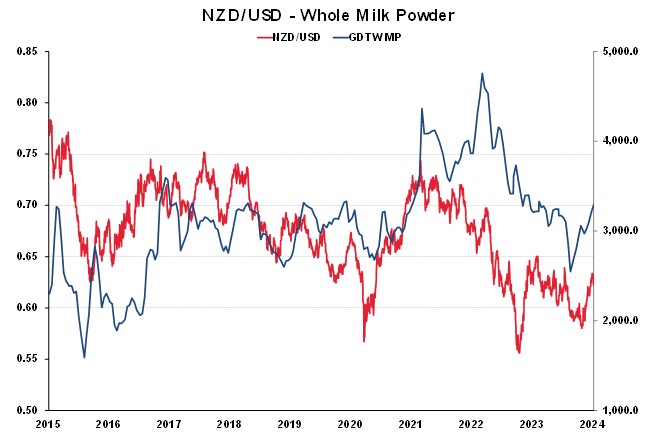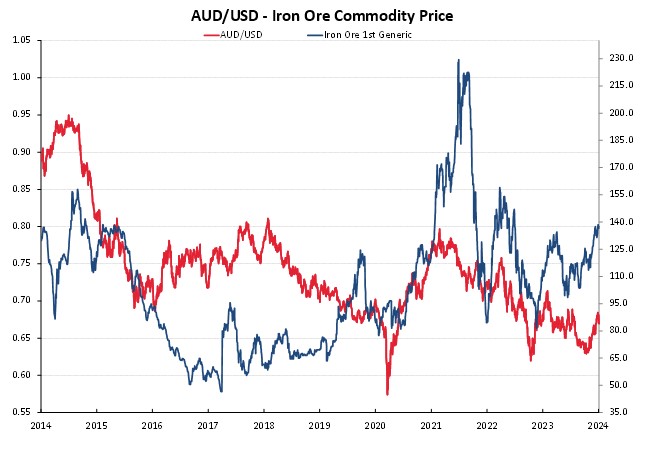
Summary of key points: -
- Mixed messages for FX markets from US jobs data to start the year
- What could derail continuing US dollar depreciation in 2024?
- Aussie and Kiwi dollars back tracking commodity prices?
Trends in US employment statistics are a crucial barometer for both the financial markets and the US Federal Reserve in determining the strength of the economy and the inflation risks (through wages) that go with that. Historical jobs numbers are not normally a good forward indicator for the direction of the economy, as business hiring and firing decisions always have a natural time-lag following changes in demand and economic activity levels. Forward-looking employment measures provide more accurate pointers for interest rate and FX markets for future economic conditions.
Last Friday’s historical US Non-Farm Payrolls number for the month of December at +216,000 new jobs was stronger than expected (prior consensus forecasts were +170,000) and the initial reaction by the markets was higher US bond yields and a higher US dollar value. Yet again, the increases in jobs were in the healthcare, government and hospitality sectors, as was the pattern for most of 2023. Increases in employment in construction, manufacturing, retail and wholesale trade sectors were again very subdued. Average employee earnings (wages) for December were also above the forecast of +0.30% at +0.40% (annual increase now +4.10%).
However, the stronger jobs figures only proved to be a short-lived positive for the US dollar on the day’s trading in the currency markets. The much more forward-looking, ISM Services survey data for December, also released last Friday, painted a considerably gloomier outlook. The Services PMI index dropped from 52.7 in November to a weak 50.6 in December (well below the expectations of an unchanged result). The PMI Services employment sub-index was a shocker at 43.3, down from 50.7 In November. If this survey is an accurate indicator for the massive and dominating services sector in the US economy, the Non-Farm Payrolls jobs numbers over coming months would appear to be in for some very weak results. Expect to see continuing US dollar depreciation if this is the case, as the markets will be increasing bets that the Fed will be cutting interest rates as soon as March. The stronger than anticipated December jobs data suggested interest rate cuts being delayed until after mid-year.
The Kiwi dollar climbed to a five-month high of 0.6360 on 28 December 2023 as the US dollar sell-off continued until the end of the year following the Fed’s pivot in early December. Local USD importers with staggered hedging orders placed higher from 0.6200 to 0.6400 over the Xmas holiday period were well rewarded, as the NZD/USD rate has subsequently pulled back to 0.6250 in the first few days trading in the New Year. A minor downward correction in the Kiwi dollar is not unexpected given the rapid five-cent rise from 0.5800 to above 0.6300 over November and December.
What can still be stated with some certainty as we enter the new year, is that the NZD/USD exchange rate will continue to be dominated by movements on the USD side of the currency equation, as has been the case for the last 18 months. Whilst the state of the NZ economy, high inflation and the Government’s own financial position are a major challenge for the new Luxon Government, the FX markets will not be marking the Kiwi dollar higher or lower solely based on NZ economic trends.
Declining US interest rates in 2024 will continue to widen the NZ:US interest rate differential and therefore favour appreciation in the NZ dollar (due to USD depreciation) to back above long-term average NZD/USD levels of 0.6700. European inflation is not falling as fast as US inflation, and this is why the ECB will be well behind the Fed in reducing their interest rates i.e. positive for the Euro.
What could derail continuing US dollar depreciation in 2024?
The central FX market view of this column remains unchanged from that of the last six months, the US dollar will continue to depreciate against all currencies in 2024 on lower US interest rates. The continuing downtrend in the US dollar cannot be expected to be smooth or even, evolving economic data will cause volatility around the timing and extent of Fed interest rate cuts this year. The underlying rationale for lower US interest rates and a lower US dollar being that US inflation being near to the 2.00% Fed target provides absolutely no justification for tight monetary policy settings at a 5.50% Fed Funds interest rate.
However, corporate managers and fund managers responsible for FX hedging levels and decisions need to take account of the risks to that weaker US dollar trend and view.
A selection of the risks that could potentially derail the anticipated continuing USD depreciation in 2024 may be summarised as follows: -
- Risk-off investor sentiment due to global geo-political tensions/risk events – The Israel/Hamas war, the Ukraine war and potential Chinese/Taiwanese tensions spring to mind. How one assigns a probability to such geo-political risk events causing USD appreciation is extremely difficult. Only the unexpected risk events cause FX market ructions, therefore given the first two wars are well entrenched and the probability of China invading Taiwan is extremely remote, the likelihood of USD gains from this source appear low.
- Escalation of trade and investment tensions between the US and China – for positive global economic growth in the post Covid inflation era, it is in no nation’s interest to turn inwards with increased trade and investment barriers. Prior to 2020, US/China trade tensions did cause “safe-haven” USD buying in currency markets. However, this factor would seem a low probability of derailing the USD downtrend in 2024.
- Donald Trump is the Republican Party candidate for the November US Presidential election – Upcoming court/legal rulings and state primaries voting will be closely watched to determine this probability. Could the American people be so crazily divided yet again?
- US economy slumps into recession, dragging the rest of the world down with it – The historical pattern of the USD always strengthening when the global economy goes into recession has been a favourite theme of FX forecasters at NZ and Aussie banks over recent times (supporting their 0.5500 NZD/USD forecasts). Well, according to the US Treasury Secretary, Janet Yellen, the US economy is in for a “soft-landing” i.e. inflation returned to target without hurting employment and slipping into recession. The probability of this risk eventuating continues to decline, and it was never that high in the first place.
The probability of a major global risk event upsetting the weaker USD trend does not appear to be any higher this year than any other year. However, the unknown can always happen and that is why financial risk managers should not have all their eggs in one basket!
Aussie and Kiwi dollars back tracking commodity prices?
Over recent years, both the NZ dollar and the Australian dollar have well and truly disconnected from their traditional drivers of exchange rate direction – their respective export commodity prices. High US interest rate have completely outweighed the commodity price factor in the FX markets over this time. Now that US interest rates are rapidly reducing; the question is whether we will we see international FX investors and traders return to buying and selling the antipodean currencies based on their commodity price trends?
Despite all the question marks being raised by many commentators about the level of Chinese demand for our commodities, the facts are that both iron ore and dairy commodity prices are currently increasing. Whilst commodity supply dynamics play as important role as the demand side in the price discovery equation, the current commodity price trends are certainly not negative for the NZD and AUD (refer charts below).


Daily exchange rates
Select chart tabs
*Roger J Kerr is Executive Chairman of Barrington Treasury Services NZ Limited. He has written commentaries on the NZ dollar since 1981.




We welcome your comments below. If you are not already registered, please register to comment.
Remember we welcome robust, respectful and insightful debate. We don't welcome abusive or defamatory comments and will de-register those repeatedly making such comments. Our current comment policy is here.